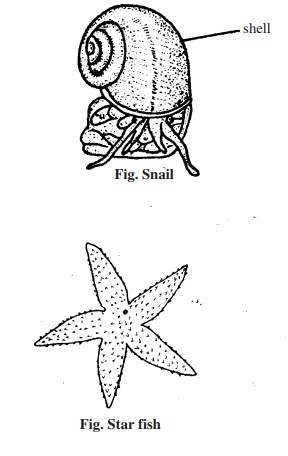Chapter: Biology: Practical Zoology
Examples of Animals taken from each of the major Phyla, their identifying Characters, Observations and Figures
Examples of Animals taken from each of the major Phyla, their identifying Characters, Observations and Figures.
Protozoa :
Amoeba (Amoeba proteus) :
1. One celled animal. microscopic
2. It always changes its shape by projecting pseuopodia.
3. There is a nucleus in its body.

Porifera:
Sponge (Spongilla fragillis):
1. Its body wall is provided with numerous pores known as ostia.
2. The adult animal remains attached permanently with some object.
3. There are various types of canal system in its body.
Cnidaria:
Hydra (Hydra viridis):
1. It has a long body. At the anterior end of , the body, there is a hypostome. Hypostome bears an opening and tentacles at its base. Opposite to hypostome is basal disc.
2. There is only one cavity in the bodyknown as coelenteron.
3. All the cells of the body are arranged in two layers, namely: ectoderm and endoderm. Mesoglea Presents in between the layers.
4. Specialized nematocysts originate in the ectoderm. It helps to catch the pray.

Platyhelminthes :
Liver Fluke (Fasciola hepatica):
1. Body soft, flat and leaf like.
2. Sucker present on the ventral side and at the anterior end of the body.
3. Mouth is present within the anterior sucker.

Nematoda:
Round Worm (Ascaris lumbricoides):
1. Body is cylindrical with two ends pointed.
2. There are four lines along the length of the body.
3. Mouth opening is present at the anterior end of the body.
4. Mouth opening is lined with three lips.

Annelida:
Earthworm Metaphire (pheretima posthuma):
1. Body is cylindrical and segmented.
2. In the middle of each segments fine setae are present.
3. On the 14th to 16th segments a band like fleshy clitellum is present.
Arthropoda:
Prawn (Macrobrachium rosenbergii):
1. Body is divided into Cephalothorax and abdomen, no tail but telson is present.
2. Head and thorax together form theCephalothorax. Body is covered byhard carapace.
3. Carapace is extended forward as a saw like rostrum.
4. Stocked compound eyes. on each side of head are present.

Mollusca:
Snail (Pila globosa):
1. The soft body is covered by a shell.
2. At the opening of the shell there is a 'C 'shaped lid.
3. The shell is spirally coiled with pointed tip.

Echinodermata:
Starfish (Asterias rubens):
1. The body is star shaped with five arms Integument is spiny.
2. They have no head.
3. Each of five arms has tube feet.
Osteichthyes:
Rui Fish (Labeo rohita):
1. Body covered with large scales.
2. There are four gills, covered by operculum.
3. The lips are fleshy.
4. The lateral line is conspicuous.
5. One pair each of pectoral and pelvic fins and unpaired dorsal, ventral and caudal fin are Present
6. Body is divided into head, trunk and tail.

Amiphibia:
Frog (Rana tigrina):
1. Body is covered by smooth integument and black-yellowish strips are present.
2. Head is triangular.
3. There are teeth on the jaw.
4. There are four fingers in the forelimb and five fingers in the hind limb.
Reptilia:
Wall Lizard (Hemidactylus brookii):
1. Body divided into head, trunk and tail.
2. Head is triangular.
3. On the two sides of the head there are a pair of eyes a pair of narial aperture and a pair of auditory aperture.
4. Two pairs of legs are present in the trunk region. Each leg has five fin:
5. Fingers are with pads.

Aves:
Crow (Corvus splendens):
1. Body covered with black feather.
2. It can fly.
3. Hard beak and two legs with claws are present.
4. In the wings there are long feathers.

Mammalia:
Rat (Rattus rattus):
1. Size of the mammal is small.
2. The tail is longer in proportion to the body; the two ears are small and remain erected.
3. The body is covered by hairs.
4. There are teeth in the jaws.
5. Whiskers present in the nasal region.
Related Topics